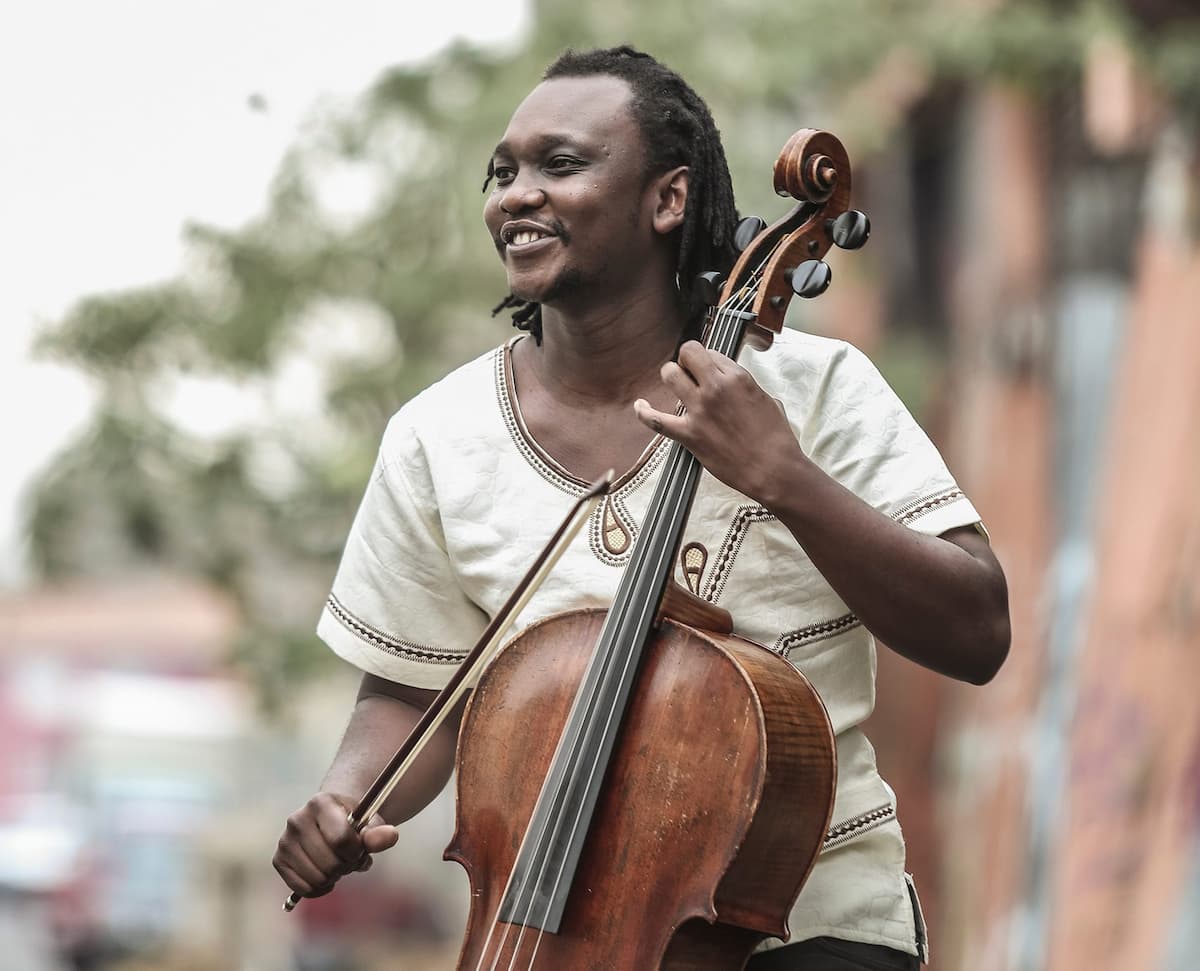South African cellist, singer, and composer Abel Selaocoe has a remarkable and inventive approach. Taking the cello to places rarely explored, he showcases the tremendous range of expression of the cello from the classics through non-Western musical traditions. His extraordinary vocal range and improvisational skills lend an added dimension—singular sounds from his African language and the use of body percussion, thereby fusing cultures, traditions, and genres.
Chesaba – Ka Bohaleng
A multi-talented innovator, his demeanor is welcoming and outgoing. The audience is drawn in. But behind the scenes, the rehearsal process is radically different than the musicians are accustomed to! Professional classical musicians are able to effortlessly translate and interpret the notes on a page of music into beautiful sounds, but most of us are not trained or very comfortable improvising. For this program, many of the pieces were taught orally by Abel, without any printed sheet music. The Artistic Planning Manager of the SPCO, Jonathan Posthuma, sat in on rehearsals scribbling notes, taking dictations, and otherwise trying to put together music for the musicians. They did an amazing job in the short amount of time to learn the complex rhythms. Posthuma also arranged some of the other works performed that night including the Heiliger Dankgesang movement from Beethoven’s String Quartet No. 15 Op. 132 for the five-string sections: Violin I, Violin II, Viola, Cello, and Double bass.
The result was a true collaborative effort to bring this singular and mesmerizing music to audiences. When I heard the performance, I thought Selaocoe changed the way many of us are accustomed to listening.

Abel Selaocoe
The program began with the Beethoven. It was written after a bout of sickness, and unusually enough for Beethoven, he expressed his joy at overcoming his illness in the third movement of the quartet. It is entitled, “Song of Thanksgiving to the Deity from a convalescent in the Lydian mode”, and intended as a musical prayer, profound, one in which Beethoven grapples with mortality. Its length, fifteen minutes, (and some play it even slower) is in itself a challenge for the performers. The structure comprises three molto adagio chorale sections interspersed with two quicker andante sections, that seem light-hearted in contrast.
The SPCO musicians played it with reverence, and the serenity of the very slow sections suspended us as they drew long bows, hymn-like, breathing as a small ensemble would. What followed was completely different.
As musicians we try to emulate effortlessness and we attempt to produce the qualities of singing on our instruments. With Selaocoe everything arises from song. His voice, a resonant baritone, suddenly nosedives into guttural low bass notes, via Xhosa-style throat singing. (Corresponding in pitch to the low D on the cello’s lowermost string the C string.) He also incorporates the “click” sound of several South African languages, and vocal percussion, creating sounds using his lips, tongue, teeth, and voice. Add to these sounds cello pyrotechniques: complex rhythms, left hand pizzicato, double notes, tremolo, glissandos—the result—nothing we’ve heard before as classical music audiences!
Abel Selaocoe (cello): Ka bohaleng, Iquawe and Bach Sarabande
Accompanying his improvisatory cello-playing was the willing SPCO ensemble, with a percussionist on maracas and bongo drums imitating Selaocoe’s pulsating, animated flourishes. The audience was on the edge of their seats. We witnessed remarkable effortlessness, an innate physical ability, irresistible energy, wonderous virtuosity, and versatility, especially in his own compositions, and he stretched our sensibilities. But his deep, profound, and unapologetic emotion touched our hearts, communicating in ways words cannot.

Where is home (Hae Ke Kae) Abel Selaocoe
The reviews were effusive. Rob Hubbard of the Minneapolis Star Tribune, said, “Thursday night’s concert was among the most thrilling I’ve experienced… Selaocoe is a unique artist with a diverse but beautifully blended set of influences…and should make his SPCO concerts a required destination for anyone seeking fresh terrain to explore for the ears, minds and hearts.”
Abel Selaocoe & Yo-Yo Ma record Ibuyile I’Africa / Africa is Back
Selaocoe started playing music at the age of nine in Sebokeng in Southern Gauteng just outside of Johannesburg and he graduated from the Royal Northern College of Music, Manchester, in 2018. He studied and performed standard cello concertos, sonatas, short pieces, and chamber music. Today collaborations with artists of every stripe have led Selaocoe to curate unique and memorable programs, with music and musicians from across the globe. His new album Where is Home was released in 2023 on Warner Classics. This is one to get!
Where Is Home (Hae Ke Kae) by Abel Selaocoe – African music meets the Baroque
In May of 2021, Abel became the inaugural ‘Power Up Music Creator’ participant in a “new initiative to address anti-Black racism and racial disparities in the music sector.” There is no limit to this artist as far as I’m concerned, and I expect he will make a huge impact.
For more of the best in classical music, sign up for our E-Newsletter



